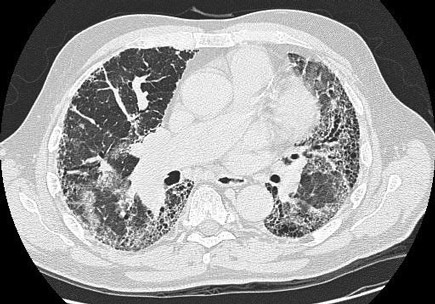DynaMed Plus image quiz: CT scan

Which of the following is the most likely cause of the findings in this high-resolution CT scan?
A. Asbestosis
B. Idiopathic pulmonary fibrosis
C. Rheumatoid arthritis
D. Scleroderma
Answer and Critique
Answer: B. Idiopathic pulmonary fibrosis.
Supporting citations for this topic are online.
Idiopathic pulmonary fibrosis is the most common cause of usual interstitial pneumonia, the type of interstitial lung disease imaged here. Idiopathic pulmonary fibrosis, which commonly affects men aged 50-75 years old, results from a dysregulated response of inflammatory cells to unknown injury resulting in interstitial fibrosis. Similar CT scans may also be seen in patients with known causes of pulmonary scarring such as scleroderma, rheumatoid arthritis, asbestosis, and sarcoidosis but in most patients with usual interstitial pneumonia, as in this patient, the cause of pulmonary scarring is unknown.
Clinical features of a usual interstitial pneumonia pattern include all of the following:
- subpleural, basal predominance
- reticular abnormality
- honeycombing with or without traction bronchiectasis
- no features inconsistent with usual interstitial pneumonia pattern
Features inconsistent with a usual interstitial pneumonia pattern include any of:
- upper or midlung predominance
- peribronchovascular predominance
- ground glass abnormality more extensive than reticular abnormality
- profuse bilateral micronodules predominantly in upper lobes
- multiple, bilateral, discrete cysts away from areas of honeycombing
- diffuse bilateral mosaic attenuation or air-trapping in ≥ 3 lobes
- consolidation in bronchopulmonary lobes or segments.




